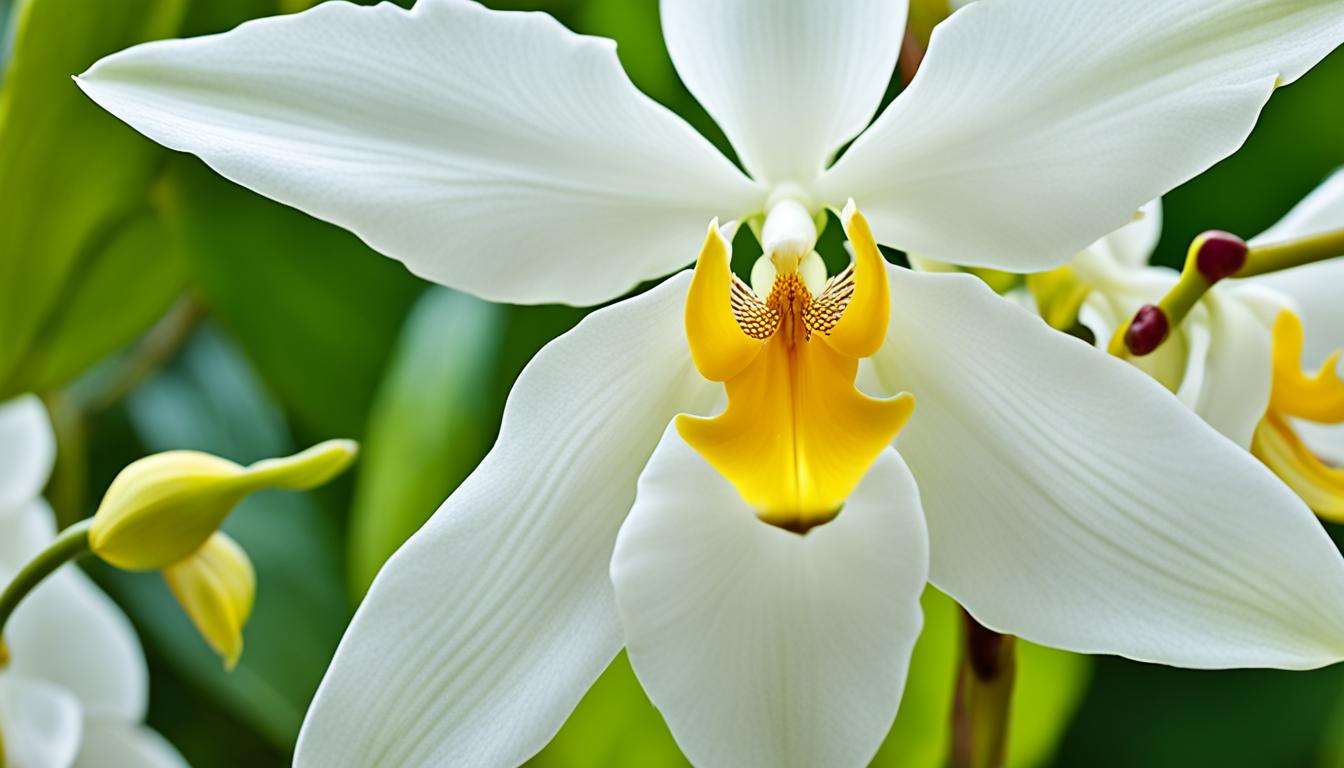I love food and always get excited by vanilla’s sweet smell and taste. Vanilla can make simple treats special, like creamy ice cream or a warm cake. I want to share with you the many types of vanilla and help you find your favorite.
This article is for anyone who loves vanilla, whether you bake often or just enjoy eating it. We’ll explore how vanilla beans are grown and their interesting history. You’ll learn about the different flavors, like Bourbon vanilla from Madagascar and Tahitian vanilla.
Vanilla is loved all over the world for its taste. We’ll talk about its health benefits and how to use it in cooking. Whether you like traditional vanilla dishes or want to try new recipes, this article will help you.
Introduction: Exploring the World of Vanilla
Vanilla is known for its rich, creamy taste and smell. It comes from the vanilla orchid’s seedpods. This spice is a key ingredient in many foods, drinks, and desserts. Let’s look at the different types of vanilla and find out which one is the best.
Varieties of Vanilla: Exploring the Spectrum of Flavors
The vanilla plant is from Mexico but grows in many places. This gives us different tastes. Bourbon vanilla is sweet and creamy, from Madagascar and Réunion.
Mexican vanilla is intense and smoky. Tahitian vanilla is fruity and floral. These types of vanilla offer many flavors to try, each special in its own way.
| Vanilla Variety | Origin | Flavor Profile |
|---|---|---|
| Bourbon Vanilla | Madagascar, Réunion | Deep, sweet, creamy |
| Mexican Vanilla | Mexico | Intense, slightly smoky |
| Tahitian Vanilla | Tahiti | Delicate, floral, fruity |
When you try vanilla, think about what makes each type special. Do you like the deep taste of Bourbon vanilla or the sweet smell of Tahitian vanilla? Vanilla can make your cooking amazing.
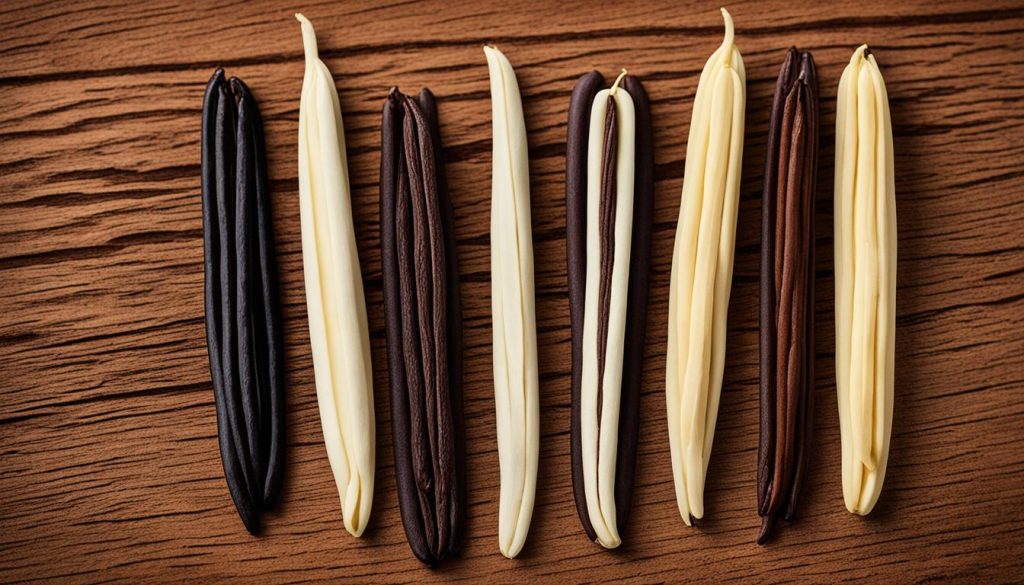
Varieties of Vanilla
Vanilla is a spice that brings many flavors to our tables. It’s not just the vanilla extract we use in baking. There are many types of vanilla, each with its own special taste. Let’s look at Bourbon vanilla, Mexican vanilla, Tahitian vanilla, and others.
Bourbon Vanilla: The Crème de la Crème
Bourbon vanilla comes from the island of Réunion, also known as Île Bourbon. It’s known as the best vanilla. It comes from the Vanilla planifolia orchid and is loved for its sweet, floral smell. Its taste has notes of caramel, chocolate, and a hint of smokiness.
Mexican Vanilla: Bold and Intense
Mexican vanilla has a strong, deep flavor. It comes from the Vanilla planifolia species. It has a spicy taste that’s different from Bourbon vanilla. This makes it great for bold desserts and cocktails.
Tahitian Vanilla: Fruity and Floral
Tahitian vanilla grows in French Polynesia and has a fruity, floral taste. It tastes like cherry, plum, and a bit like anise. This vanilla is great for many foods, sweet or savory.
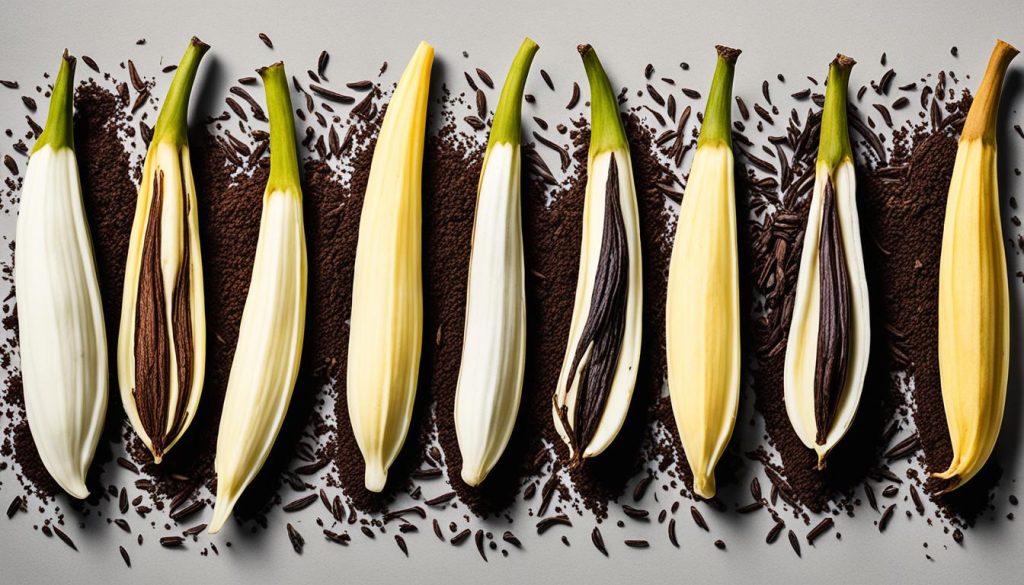
Do you like the smooth taste of Bourbon vanilla, the strong taste of Mexican vanilla, or the fruity taste of Tahitian vanilla? Vanilla comes in many flavors for every taste. Try these different types and see which one you like best.
The Origins of Vanilla
Vanilla making is very hard work, but it makes a flavor loved by people all over the world. Let’s explore the interesting history and journey of this spice, from where it started to how it’s made.
Vanilla Growing and Harvesting
The vanilla vine is a special plant that needs a lot of care. Every year, the flowers must be pollinated by hand during a short time. This was found by a young slave named Edmond Albius in the 19th century.
This discovery changed the vanilla industry worldwide. It made it possible to grow vanilla outside of its home in Mexico.
After pollination, the vanilla beans take a few months to get ready. This is when they start to smell and taste like vanilla. The curing process can take up to 12 weeks. It includes sun-drying, sweating, and conditioning steps that change the green pods into the dark, shriveled beans we all know.
| Stage | Duration | Purpose |
|---|---|---|
| Hand-pollination | Annual | Enables vanilla cultivation outside of Mexico |
| Maturation | Several months | Allows the pods to develop aroma and flavor |
| Curing | Up to 12 weeks | Transforms green pods into dark, shriveled vanilla beans |
This hard work shows how much effort and creativity vanilla growers and harvesters put in. They work hard to share this amazing flavor with us.
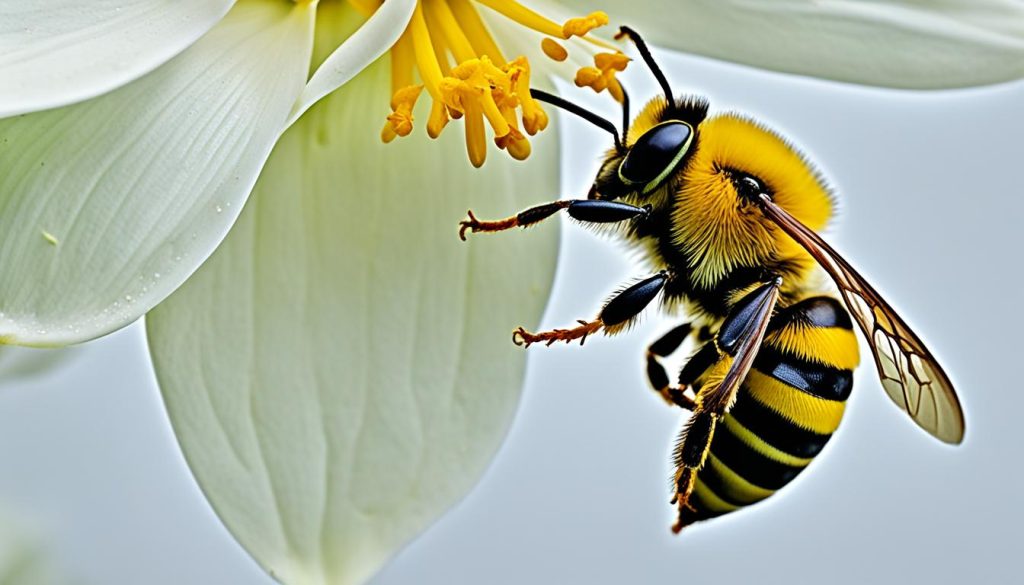
Vanilla is the second most valuable spice after saffron because the plant is very labor-intensive to grow and it is difficult to pollinate.
Vanilla
Vanilla is a top flavor worldwide, with a history since the 17th century. It has won over people’s taste buds globally, becoming key in many foods and drinks. Let’s explore why vanilla is a top choice in cooking.
The Allure of Vanilla Flavor
Vanilla’s fame comes from its special taste. It mixes sweetness, creaminess, and complexity well with many foods. Vanilla makes vanilla cakes, cookies, and ice cream even better.
Vanilla’s Versatility Shines
Vanilla is amazing in many ways. You can find it in foods like baked goods and drinks, and even in cleaners. Its wide use shows how much people love it and how it fits into many things.
| Vanilla Product | Application |
|---|---|
| Vanilla Extract | Baking, Flavoring |
| Vanilla Beans | Infusing Drinks, Desserts |
| Vanilla Powder | Beverages, Cosmetics |
| Vanilla Syrup | Cocktails, Coffee Drinks |
There are many vanilla products out there, showing how much people like it. Vanilla fits into many foods and non-food items, making it very popular.
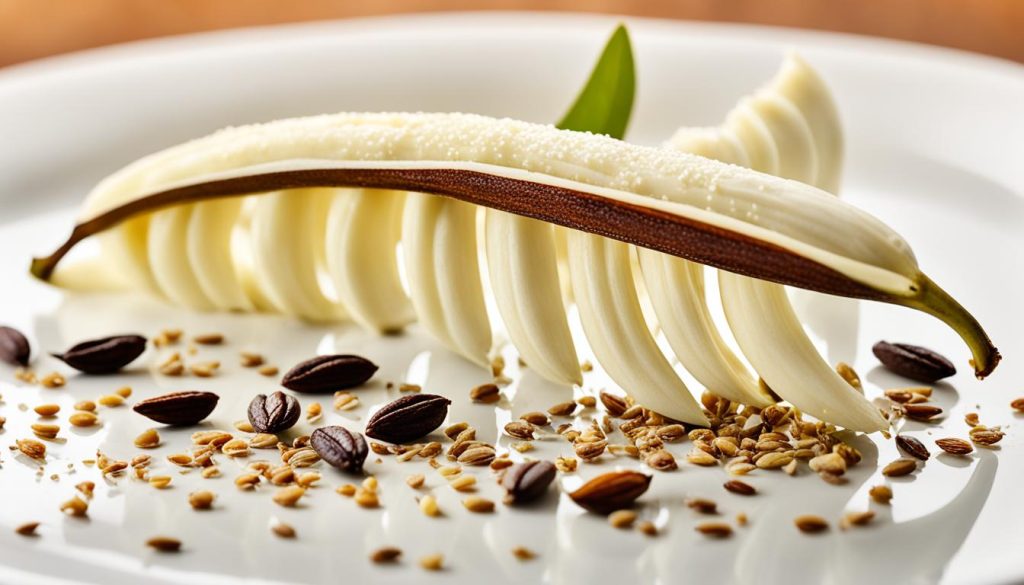
Vanilla is the world’s most popular flavor, and it’s easy to see why. Its warm, comforting aroma and delicate sweetness make it a beloved ingredient in countless recipes.”
Health Benefits of Vanilla
Vanilla is known for its tasty flavor, but it also has many health benefits. As someone who loves vanilla, I’m excited to share what I’ve learned about it.
One big health perk of vanilla is its antioxidants. Vanilla has compounds called vanilloids. These act as antioxidants, fighting off bad free radicals in our bodies. This can lower the risk of chronic diseases and help keep cells healthy.
Vanilla can also help with inflammation. Studies show that vanilla’s compounds might reduce inflammation. This could help with conditions like arthritis, muscle pain, and skin issues.
But there’s more to vanilla’s benefits. Its sweet smell can make you feel calmer and happier. Vanilla scent is linked to less stress and better mood. It’s a natural way to support your mental and emotional health.
| Health Benefit | Supporting Evidence |
|---|---|
| Antioxidant Properties | Vanilla contains vanilloids, which act as powerful antioxidants to neutralize free radicals. |
| Anti-Inflammatory Effects | The compounds in vanilla may possess anti-inflammatory properties, potentially aiding in the management of certain conditions. |
| Mood-Boosting Abilities | The captivating aroma of vanilla has been linked to reduced stress levels and improved feelings of well-being. |
Vanilla’s health perks go way beyond its great taste. It can help with your overall health, fight inflammation, or just make you feel better. Adding vanilla to your diet and life can be tasty and good for you.
“Vanilla is not just a flavor – it’s a powerful ally in supporting your health and well-being.”
Classic Recipes and Creative Twists
Vanilla makes both sweet and savory dishes better. It goes from classic vanilla cakes and cookies to new vanilla cocktails and marinades. This flavor opens up many cooking chances.
Indulge in Timeless Vanilla Desserts
Some vanilla recipes are timeless. Vanilla custards, crème brûlée, and vanilla-bean ice cream are loved for their creamy taste and smell. They’re great for a sweet treat and a special dessert moment.
Elevate Savory Dishes with Vanilla
Vanilla isn’t just for sweets. It can also make savory dishes better. Use vanilla in marinades, sauces, or with roasted meats and veggies. Vanilla adds a special taste that turns simple meals into something amazing.
Get Creative with Vanilla
Vanilla offers endless chances to get creative. You can make vanilla cocktails, syrups, dressings, and glazes. Let your cooking skills shine by finding new ways to use vanilla in desserts and more.
“Vanilla may be the most popular flavor in the world, but that doesn’t mean it has to be boring. Get creative and discover the endless possibilities of this exquisite ingredient.”
Vanilla can make any dish better, whether you’re a pro or just starting. Try the classic and get creative with this favorite flavor.
From Pod to Extract
The journey from vanilla bean to the extracts, pastes, and powders we love is fascinating. It shows us how these pods turn into the spices we use in our kitchens. This process not only satisfies our curiosity but also helps us appreciate vanilla’s nuances.
The Art of Vanilla Bean Processing
Vanilla bean processing starts with hand-pollinating the vanilla orchid flowers. This is a hard job done by skilled farmers. Then, the beans go through a careful curing process.
They are dried, fermented, and conditioned to get their rich, aromatic flavors. This process is key to the unique tastes we know.
Extracting the Essence
To make vanilla extract, the cured beans soak in a mix of alcohol and water. This lets the tasty compounds come out. The liquid is then bottled and aged, which changes the flavor’s depth and intensity.
Vanilla paste is made by mixing vanilla extract with vanilla bean specks. It gives a thicker, more intense flavor.
Powdery Perfection
Vanilla powder is made by grinding the dried beans into a fine powder. It keeps the bean’s flavor but is easier to use, especially in baking. This is because it spreads evenly in recipes.
Each type of vanilla has its own uses in cooking. This lets you pick the best one for your recipes. It brings out the best in this amazing spice.
“The aroma of vanilla is so intoxicating, it’s like a drug. I get a rush every time I smell it.”
– Chef Emeril Lagasse
Madagascar: The Vanilla Capital
Madagascar is the top producer of vanilla, earning it the title of vanilla capital. The island’s Bourbon vanilla beans are famous for their rich, creamy taste. Chefs, bakers, and vanilla lovers around the world adore them.
What makes Madagascar’s vanilla special? It’s the traditional way Malagasy farmers grow and cure the beans. They hand-pollinate the pods and dry them carefully. This hard work makes Madagascar’s vanilla some of the best in the world.
Madagascar leads not just in quality but also in sustainable vanilla production. Farmers focus on growing vanilla in a way that helps the planet. They use good farming methods and help their communities. This approach protects the vanilla supply and helps farmers and their families.

